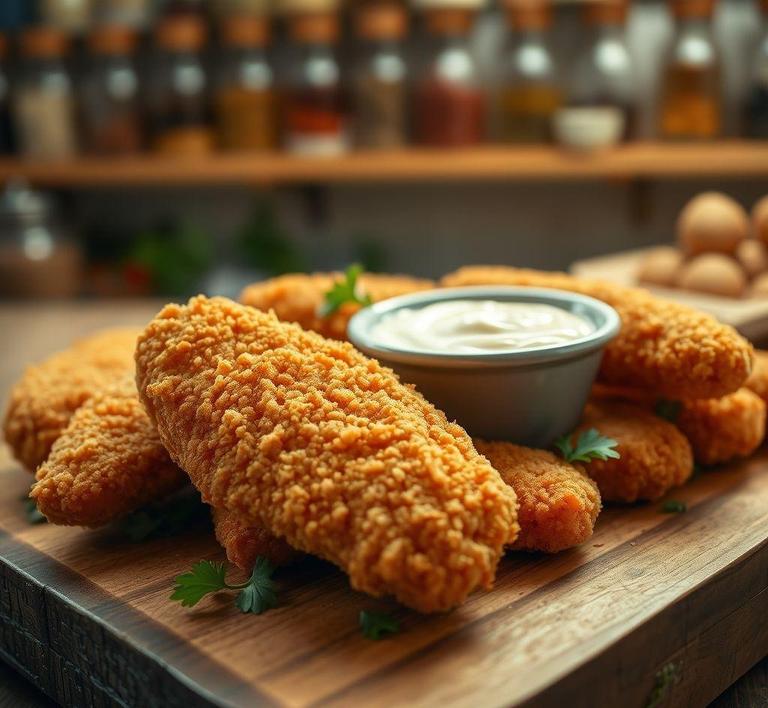Refreezing chicken fingers is a topic that many of us wonder about, especially when we have leftovers or want to make a batch in advance for later. Whether you’ve got extra chicken fingers from a family meal or just want to stock up for busy days, it’s important to know the right way to store them so they taste fresh when reheated. The process can be a little tricky, as improper handling can lead to sogginess or even food safety concerns, but with the right technique, you can refreeze chicken fingers without sacrificing taste or texture. Let’s dive into some tips and guidelines to make sure your chicken fingers are just as crispy and delicious the second time around!
Can You Refreeze Chicken Fingers?

Yes, you can refreeze chicken fingers, but with an important caveat: it depends entirely on how they were handled after their initial thawing. If the chicken fingers were thawed in the refrigerator and have not spent more than two hours at room temperature (or just one hour if the ambient temperature was above 90°F/32°C), they can be safely refrozen. However, if they were thawed on the countertop, in warm water, or in a microwave and then sat for a while, refreezing them is not recommended due to potential bacterial growth.
It’s also essential to distinguish between raw and cooked chicken fingers. Refreezing cooked chicken fingers is generally safer, assuming they were stored properly. In contrast, raw chicken fingers that have been improperly thawed pose a higher risk of developing harmful bacteria like Salmonella or Campylobacter.
How To Refreeze Chicken Fingers?
If your chicken fingers pass the safety check, here’s how to properly refreeze them to preserve quality as much as possible:
-
Cool Completely (for cooked chicken fingers):
Before refreezing, make sure the chicken fingers are completely cooled. Freezing warm food can create ice crystals, degrade texture, and raise the freezer’s temperature, potentially affecting other stored food.
-
Wrap Individually:
Wrap each chicken finger tightly in plastic wrap or aluminum foil. This helps prevent freezer burn and protects against moisture loss.
-
Use Airtight Packaging:
Place the individually wrapped chicken fingers in a heavy-duty freezer bag or an airtight container. Remove as much air as possible to reduce the chance of oxidation and preserve flavor.
-
Label and Date:
Don’t forget to label your packaging with the date. While refrozen chicken fingers can be safe for up to 2 months, they’re best consumed within a month for optimal taste and texture.
-
Freeze Quickly:
Make sure your freezer is at 0°F (-18°C) or colder. Quick freezing helps reduce the size of ice crystals, which can damage the cellular structure of the meat and result in a mushy texture upon reheating.
Quality Impact
While refreezing chicken fingers is safe if done properly, the process can significantly impact their texture and flavor. The main culprits here are ice crystals and moisture loss.
When chicken fingers are frozen the first time, small ice crystals form within the meat. If thawed and then refrozen, larger ice crystals develop, which can rupture the muscle fibers. This often results in a drier, more rubbery texture once the chicken fingers are reheated.
Additionally, breading can become soggy or separate from the meat entirely after being frozen, thawed, and refrozen. This is especially true for fried or oven-baked varieties, where crispiness is key. You may also notice flavor degradation – subtle notes that once contributed to the savory depth of the chicken finger might be dulled or lost entirely.
One way to combat these issues is to reheat refrozen chicken fingers in an oven or air fryer rather than a microwave, which can help restore some of the original texture.
Refreezing chicken fingers is a safe practice – but only if you follow strict guidelines for handling, cooling, and packaging. Ensuring they were initially thawed safely is the first and most crucial step. Proper wrapping and quick freezing will help mitigate some of the negative effects on texture and flavor.
However, while it’s possible to refreeze them, it’s not always ideal. The second freeze-thaw cycle inevitably affects quality, particularly in terms of juiciness and crunch. When possible, portion out your chicken fingers before freezing to avoid unnecessary thawing and refreezing. But when circumstances demand it, rest assured: if handled properly, refreezing won’t turn your chicken fingers into a safety hazard – just be prepared for a minor drop in culinary satisfaction.
Is It Safe To Refreeze Chicken Fingers?
The question of whether you can safely refreeze chicken fingers is one that requires a nuanced answer. In short: yes, you can refreeze chicken fingers-but only under specific circumstances. The key factor is temperature control. If the chicken fingers have been thawed in the refrigerator and have not been out at room temperature for more than two hours (or one hour if the ambient temperature exceeds 90°F/32°C), they can be refrozen safely. This guideline aligns with USDA food safety recommendations, which emphasize minimizing bacterial growth.
However, if the chicken fingers were thawed using faster methods like in the microwave or under cold water, they must be cooked before refreezing. This is because these methods may bring the food into the "danger zone" (40°F to 140°F), a temperature range in which bacteria such as Salmonella and Listeria can multiply rapidly. Refreezing raw or cooked chicken fingers that have entered this zone for extended periods significantly increases the risk of foodborne illness.
Refreezing may also affect texture and flavor. Moisture loss during the initial freeze and thaw cycle can lead to a drier, tougher bite upon reheating. Breaded chicken fingers are particularly susceptible, as the coating may become soggy or separate from the meat after multiple freeze-thaw cycles.
Signs That Chicken Fingers Should Not Be Refrozen
Even when following general food safety guidelines, it’s critical to use your senses and judgment. Here are clear warning signs that chicken fingers should not be refrozen:
- Off Odor: A sour, rancid, or otherwise foul smell is a red flag. Chicken should have a neutral or mildly savory aroma. Any pungent scent is indicative of spoilage.
- Slimy or Sticky Texture: If the surface of the chicken fingers feels unusually slimy, tacky, or filmy, bacterial growth may already be underway.
- Discoloration: While slight color changes due to oxidation are natural, gray, green, or blotchy discolorations can signal spoilage or microbial contamination.
- Ice Crystals or Freezer Burn: Extensive freezer burn-white, dry patches or crystals on the surface-indicates moisture loss and potential quality degradation. While not unsafe, severely freezer-burned chicken should not be refrozen again, as the texture and taste will suffer significantly.
- Time Spent at Room Temperature: If the chicken fingers have been left out for over two hours, or one hour in hotter climates, they must not be refrozen. Bacterial growth can occur rapidly under these conditions.
Common Refreezing Mistakes
Many well-meaning home cooks unknowingly make errors that compromise both food safety and quality. Here are some of the most common missteps:
- Refreezing After Microwave Thawing: Microwaving can bring parts of the food to unsafe temperatures. Unless you cook the chicken immediately after thawing this way, refreezing is unsafe.
- Not Labeling or Dating Frozen Items: It’s easy to lose track of how long something has been frozen. Without clear labeling, you might refreeze items that have already been through a full freeze-thaw cycle or are past their recommended storage time (typically 1 to 3 months for optimal taste).
- Refreezing Large Quantities: Thawing and refreezing a large batch of chicken fingers multiple times creates temperature inconsistencies, increasing the risk of bacterial proliferation.
- Using Inappropriate Containers: Refreezing in thin plastic wrap or loosely sealed bags exposes food to freezer burn and contamination. Properly sealed, airtight, and freezer-safe containers are essential.
- Not Allowing Chicken to Cool Properly Before Refreezing: If you’ve cooked the thawed chicken fingers and want to refreeze them, ensure they are completely cooled before sealing and freezing. Sealing hot or warm food traps steam, increasing moisture content and ice crystal formation.
Tips And Tricks
Want to ensure your chicken fingers remain delicious and safe through multiple freeze-thaw cycles? Follow these expert tips:
- Portion Before Freezing: Freeze chicken fingers in meal-sized portions. This reduces the need to thaw and refreeze large quantities, preserving texture and flavor.
- Use a Vacuum Sealer: Vacuum-sealed packaging helps lock out air and moisture, reducing freezer burn and maintaining quality.
- Flash Freeze for Breaded Items: Lay chicken fingers out on a baking sheet in a single layer and freeze them for a few hours before transferring them to a freezer bag. This prevents sticking and helps maintain the crisp coating.
- Label Clearly: Include the date of freezing, whether the chicken is raw or cooked, and the number of refreeze cycles (if any). This makes it easy to track freshness and plan meals accordingly.
- Reheat to Safe Temperatures: When reheating previously frozen chicken fingers, bring them to an internal temperature of at least 165°F (74°C) to kill any lingering bacteria.
Conclusion
Refreezing chicken fingers isn’t inherently dangerous, but it does come with specific conditions and caveats. Safe refreezing hinges on how the chicken was thawed, how long it was left out, and how it’s stored afterward. Always prioritize food safety by following USDA guidelines, paying attention to sensory cues like smell and texture, and using proper packaging techniques.
When done correctly, refreezing can help reduce food waste and stretch your grocery budget without sacrificing health or flavor. Armed with the right knowledge and a few smart kitchen practices, you can enjoy your favorite crispy chicken bites with peace of mind and a satisfied palate.


